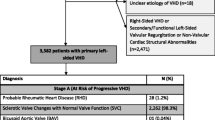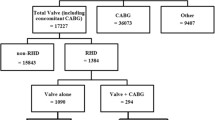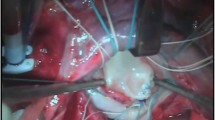Abstract
The aim of the study was to investigate the pattern of valvular lesions, the mortality and the challenges in five years follow-up in children with post-rheumatic valvulopathies in natural history in St. Elizabeth Catholic General hospital Shisong, cardiac centre. This retrospective analysis included 270 patients aged between 5 and 16 years old suffering from post-rheumatic valvulopathies who consulted in the cardiac centre from July 2008 through July 2013. Postrheumatic valvulopathies were diagnosed according to the World heart federation criteria. Data from patients’ records, two-dimensional echocardiographic studies, and electrocardiograms were reviewed. Patients and their family were contacted every six months. The duration of the follow-up was 60months. Patients aged between 5 and 16 years old with a mean age of 12.4±4.5 years. Female gender was representing 63% (n=170) of the population. Surgery was indicated in 256 cases. Lesions of the valves needing prophylaxis with penicillin was diagnosed in 14 cases. In 95 patients surgical correction could not be performed. Mitral regurgitation was the commonest echocardiographic diagnosis present in 61.5%, n=164 patients; 38.5%, n=103 patients had aortic regurgitation. Mitral stenosis and mitral disease were also represented in 6%, n=16, and 8%, n= 21 patients respectively. Pulmonary hypertension was the common echocardiographic complication of the disease in=234, 87% of cases. Clinically, complications of the disease included congestive heart failure (n=229, 85%), growth retardation (n=162, 60%), sudden death (n=27, 10%). On presentation, n=210, 78% of cases were admitted. Mortality in two years was 35%, (p≤0.05, 95% CI=2.5–6.5), in five years was 65% (p≤ 0.05, 93% CI= 2.7–7.21). The challenges faced are patients’ negligence and poor discipline, wrong beliefs, poverty. Post-rheumatic mitral valve regurgitation is the pathology the most encountered. Pulmonary hypertension is the most common echocardiographic complication of the disease. Five years mortality is very high in our setting. Due to financial limitation and illiteracy of parents, the follow up of patients is difficult.
Résumé
L’objectif de l’étude était d’observer sur cinq ans l’évolution des lésions valvulaires, la mortalité et les défis sur des enfants porteurs de valvulopathies post rhumatismales en « histoire naturelle » au Centre cardiaque du Ste. Elizabeth Catholic General hospital de Shisong. 270 patients âgés de 5 à 16 ans, souffrant de valvulopathies post-rhumatismales et ayant consulté au Centre cardiaque de Shisong de juillet 2008 à juillet 2013 ont été inclus dans cette analyse rétrospective. Les valvulopathies post-rhumatismales étaient diagnostiquées en utilisant les critères de la Fédération mondiale du coeur. Les données des fichiers des malades, des études échocardiographiques bidimensionelles et des électrocardiogrammes ont été consultées. Les malades et leurs familles étaient contactés bi-annuellement. La durée du suivi était de 60 mois. L’âge moyen des patients était de 12,4±4,5 ans. Le sexe féminin représentait 63 % des cas (n = 230). La chirurgie était indiquée dans 94 % des cas (n = 256). Les lésions valvulaires nécessitant une prophylaxie par pénicilline concernaient 14 personnes. La correction chirurgicale des valvulopathies n’a pas pu être effectuée chez 95 enfants. L’insuffisance mitrale était le diagnostic échocardiographique le plus commun, présent chez 61,5 % des patients (n = 164); 38,5 % (n = 103) avaient une insuffisance aortique, 6 % (n = 16) une sténose mitrale, 8 % (n = 21) une maladie mitrale L’hypertension pulmonaire était la complication la plus commune de la maladie, trouvée chez 87 % des patients (n = 234). Cliniquement, les complications de lamaladie incluaient l’insuffisance cardiaque congestive, dans 85 % des cas (n = 229), le retard de croissance (n = 162, 60 %), la mort subite (n = 27, 10 %). À la première présentation, 78 % (n = 210) des malades étaient hospitalisés. La mortalité après deux ans était de 35 % (p ≤ 0,05, 95 % CI = 2,5–6,5), et après cinq ans de 65 % (p ≤ 0,05, 93 % CI = 2,7–7,21). Les défis rencontrés sont: la négligence de la part des malades, l’absence de discipline, les croyances, la pauvreté. Dans notre étude, l’insuffisance mitrale postrhumatismale est la pathologie prévalente et l’hypertension pulmonaire, la complication échocardiographique la plus commune. La mortalité après cinq ans est très élevée dans notre contexte. La situation financière précaire et le manque d’éducation des parents rendent le suivi bien difficile.
Similar content being viewed by others
References
Baumgartner H, Hung J, Bermejo J, et al (2009) Echocardiographic assessment of valve stenosis: EAE/ASE recommendations for clinical practice. J Am Soc Echocardiogr 22(1):1–23
Caldarone CA, Raghuveer G, Hills CB, et al (2001) Long-term survival after mitral valve replacement in children aged <5 years: a multi-institutional study. Circulation 104(12 Suppl 1):I143–7
Carapetis JR, Mc Donald M, Wilson NJ (2005). Acute rheumatic fever. Lancet 366(9480):155–68
Carapetis JR, Steer AC, Mulholland EK, Weber M (2005) The global burden of group A streptococcal diseases. Lancet Infect Dis 5(11):685–94
Chelo D, Nguefack F1, Menanga AP, et al (2016) Spectrum of heart diseases in children: an echocardiographic study of 1,666 subjects in a pediatric hospital, Yaounde, Cameroon. Cardiovasc Diagn Ther 6(1):10–9
Ciss AG, Diarra O, Dieng PA et al (2009) La plastie mitrale sur valve rhumatismale chez l’enfant au Sénégal: à propos de 100 cas. Méd Trop (Mars) 69(3):278–80
Gunther G, Asmera J, Parry E (2006) Death from rheumatic heart disease in rural Ethiopia. Lancet 367(9508):391
Hillman ND, Tani LY, Veasy LG, et al (2004) Current status of surgery for rheumatic carditis in children. Ann Thorac Surg 78 (4):1403–8
Jackson SJ, Steer AC, Campbell H (2011) Systematic Review: Estimation of global burden of non-suppurative sequelae of upper respiratory tract infection: rheumatic fever and post-streptococcal glomerulonephritis. Trop Med Int Health 16(1):2–11
Kingué S, Ba SA, Balde D, et al (2016) The VALVAFRIC study: A registry of rheumatic heart disease in Western and Central Africa. Arch Cardiovasc Dis 109(5):321–9
Lambert AS (2007) Proximal Isovelocity Surface area Should be Routinely Measured in Evaluating Mitral regurgitation: A core review. Anesth Analg 105(4):940–3
Lubega S, Aliku T, Lwabi P (2014) Echocardiographic pattern and severity of valve dysfunction in children with rheumatic heart disease seen at Uganda Heart Institute, Mulago hospital. Afr Health Sci 14(3):617–25
Marijon E, Ou P, Celermajer DS, et al (2007) Prevalence of rheumatic heart disease detected by echocardiographic screening. N Engl J Med 357(5):470–6
Mirabel M, Narayanan K, Jouven X, Marijon E (2014) Cardiology patient page. Prevention of acute rheumatic fever and rheumatic heart disease. Circulation 130(5):e35–7
Moraldo M, Cecaro F, Shun-Shin M, et al (2013) Evidence-based recommendations for PISA measurements in mitral regurgitation: systematic review, clinical and in-vitro study. Int J Cardiol 168 (2):1220–8
Oli K, Asmera J (2004) Rheumatic heart disease in Ethiopia: could it be more malignant? Ethiop Med J 42(1):1–8
Quiñones MA, Otto CM, Stoddard M, et al (2002) Recommendations for quantification of Doppler echocardiography: a report from the Doppler Quantification Task Force of the Nomenclature and Standards Committee of the American Society of Echocardiography. J Am Soc Echocardiogr 15(2):167–84
Reményi B, Wilson N, Steer A, et al (2012) World Heart Federation criteria for echocardiographic diagnosis of rheumatic heart disease- -an evidence-based guideline. Nat Rev Cardiol 9(5):297–309
Rochae Silva A, Herdy GV, Vieira AA, Simões LC (2009) Surgical mitral valve repair in children with rheumatic fever. Arq Bras Cardiol 92(6):400–4, 417-21, 433-8
Sachweh JS, Tiete AR, Mühler EG, et al (2007) Mechanical aortic and mitral valve replacement in infants and children. Thorac Cardiovasc Surg 55(3):156–62
Sampaio RO, Fae KC, Demarchi LM, et al (2007) Rheumatic heart disease: 15 years of clinical and immunological follow-up. Vasc Health Risk Manag 3(6):1007–17
Tantchou Tchoumi JC, Butera G (2009) Rheumatic valvulopathies occurence, pattern and follow-up in rural area: the experience of the Shisong Hospital, Cameroon. Bull Soc Pathol Exot 102 (3):155–8 [http://www.pathexo.fr/documents/articles-bull/T102-3-3368-4p.pdf]
van Doorn C, Yates R, Tsang V, et al (2000) Mitral valve replacement in children: mortality, morbidity, and haemodynamic status up to medium term follow up. Heart 84(6):636–42
Voelkel NF, Quaife RA, Leinwand LA, et al (2006) Right ventricular function and failure: report of a National Heart, Lung, and Blood Institute working group on cellular and molecular mechanisms of right heart failure. Circulation 114(17):1883–91
Zühlke L, Engel ME, Lemmer CE, et al (2016) The natural history of latent rheumatic heart disease in a 5 year follow-up study: a prospective observational study. BMC Cardiovasc Disord 16:46
Zühlke L, Mirabel M, Marijon E (2013) Congenital heart disease and rheumatic heart disease in Africa: recent advances and current priorities. Heart 99(21):1554–61
Author information
Authors and Affiliations
Corresponding author
About this article
Cite this article
Tantchou Tchoumi, J.C., Ambassa, J.C. & Butera, G. Children with post-rheumatic valvulopathies in natural history: five years follow-up in the cardiac centre, St. Elizabeth Catholic General hospital Shisong (Cameroon). Bull. Soc. Pathol. Exot. 109, 340–344 (2016). https://doi.org/10.1007/s13149-016-0512-3
Received:
Accepted:
Published:
Issue Date:
DOI: https://doi.org/10.1007/s13149-016-0512-3




